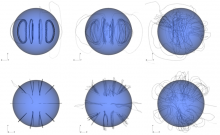
Abstract
Strong magnetic fields play an important role in powering the emission of neutron stars. Nevertheless a full understanding of the interior configuration of the field remains elusive. In this work, we present General Relativistic MagnetoHydroDynamics simulations of the magnetic field evolution in neutron stars lasting 500 ms (5 Alfven crossing times) and up to resolutions of 0.231 km using Athena++. We explore two different initial conditions, one with purely poloidal magnetic field and the other with a dominant toroidal component, and study the poloidal and toroidal field energies, the growth times of the various instability-driven oscillation modes and turbulence. We find that the purely poloidal setup generates a toroidal field which later decays exponentially reaching 1% of the total magnetic energy, showing no evidence of reaching equilibrium. The initially stronger toroidal field setup, on the other hand, loses up to 20% of toroidal energy and maintains this state till the end of our simulation. We also explore the hypothesis, drawn from previous MHD simulations, that turbulence plays an important role in the quasi equilibrium state. An analysis of the spectra in our higher resolution setups reveal, however, that in most cases we are not observing turbulence at small scales, but rather a noisy velocity field inside the star. We also observe that the majority of the magnetic energy gets dissipated as heat increasing the internal energy of the star, while a small fraction gets radiated away as electromagnetic radiation.